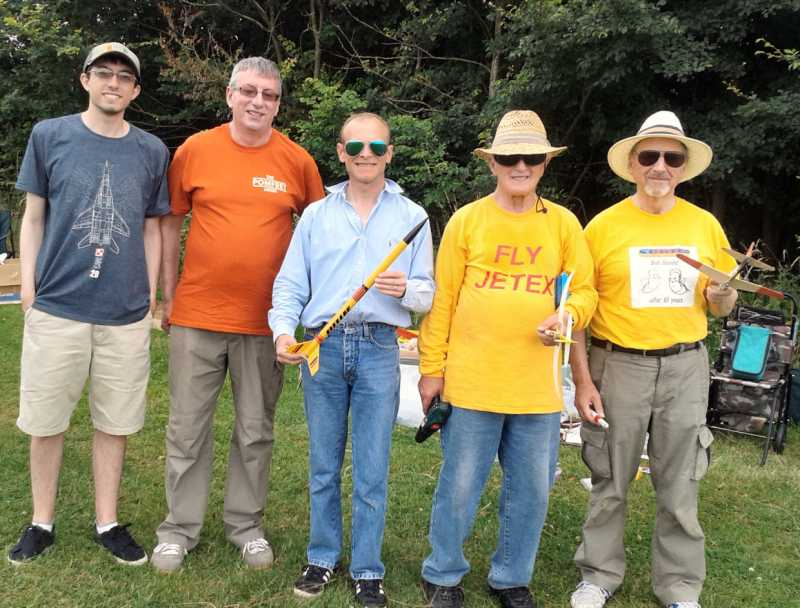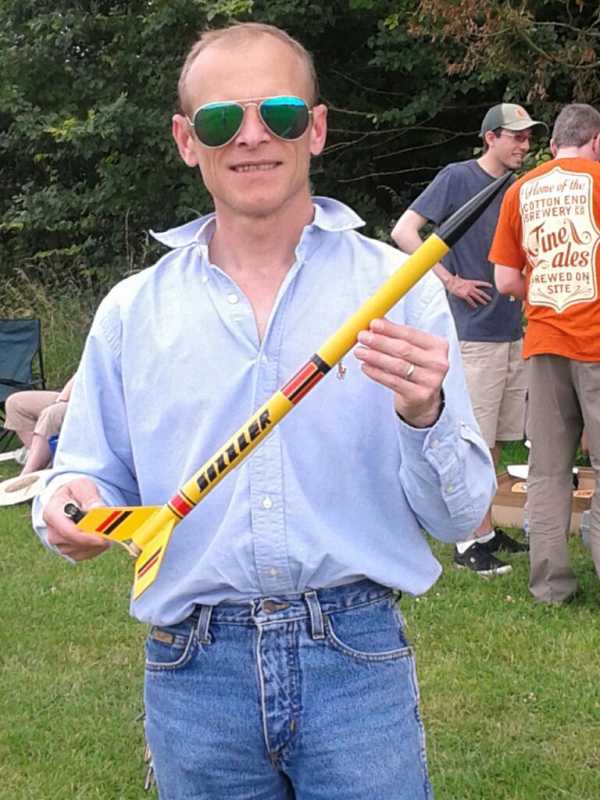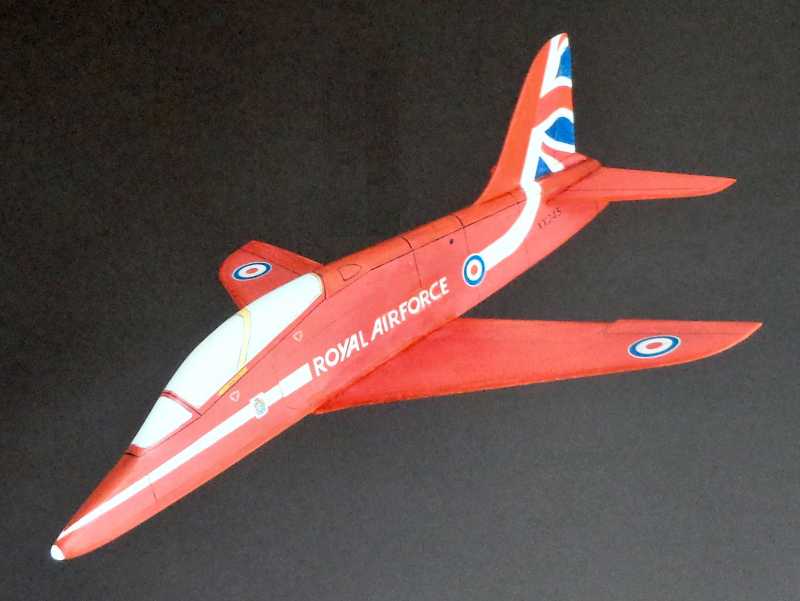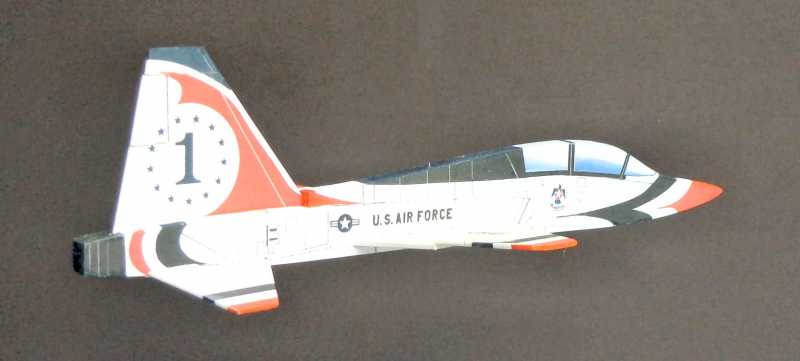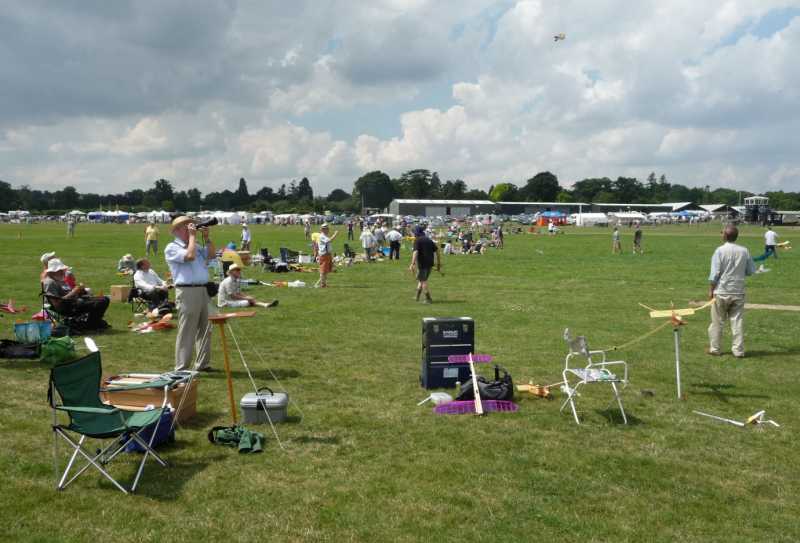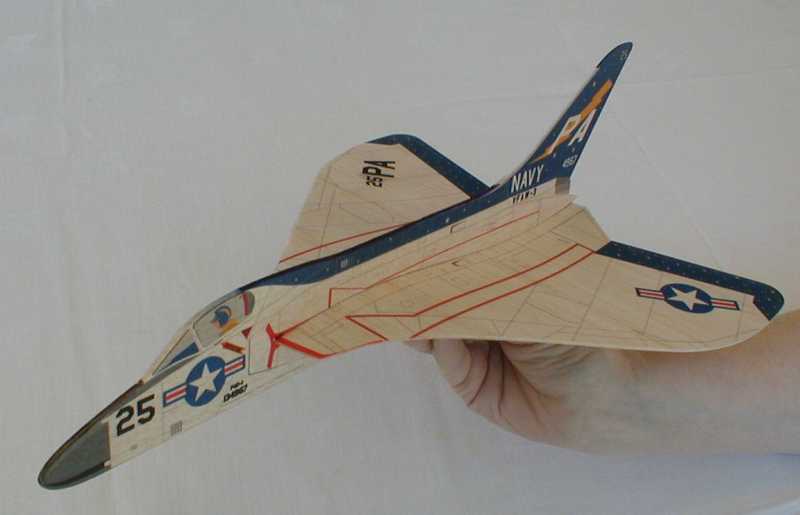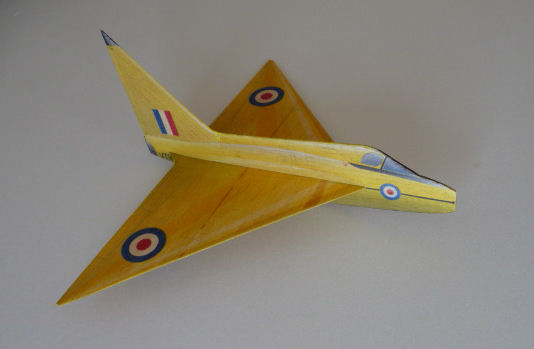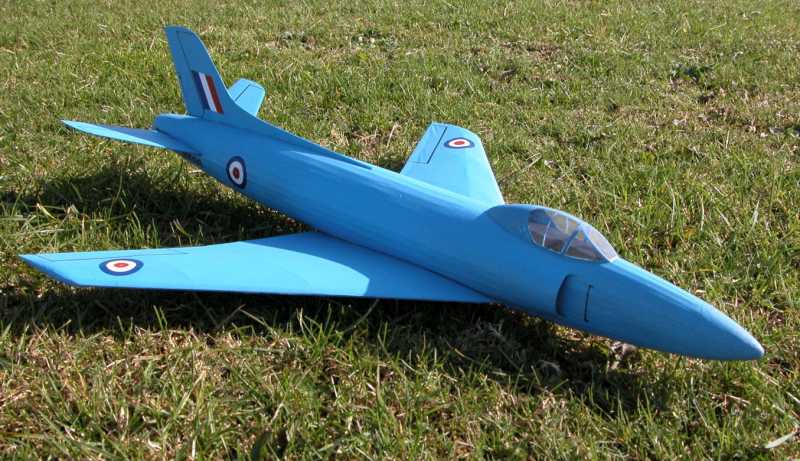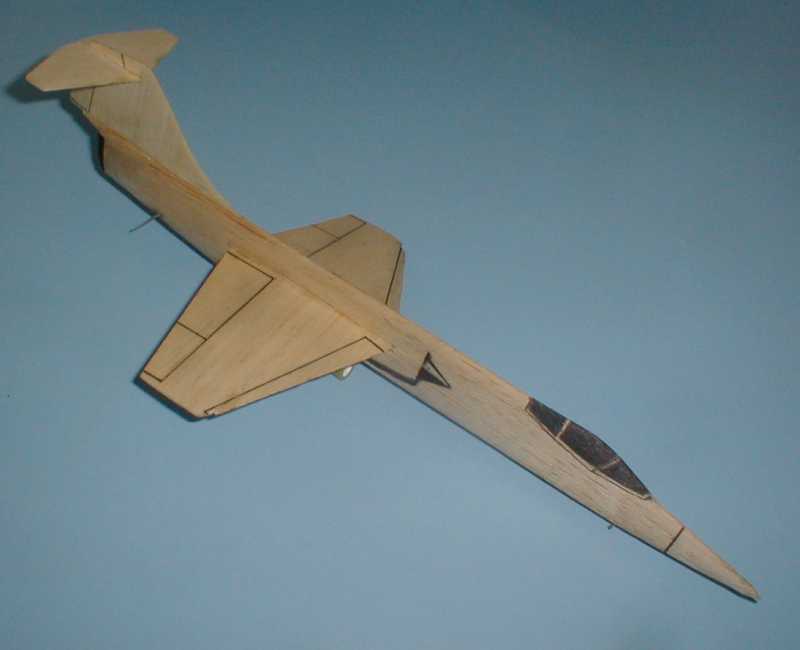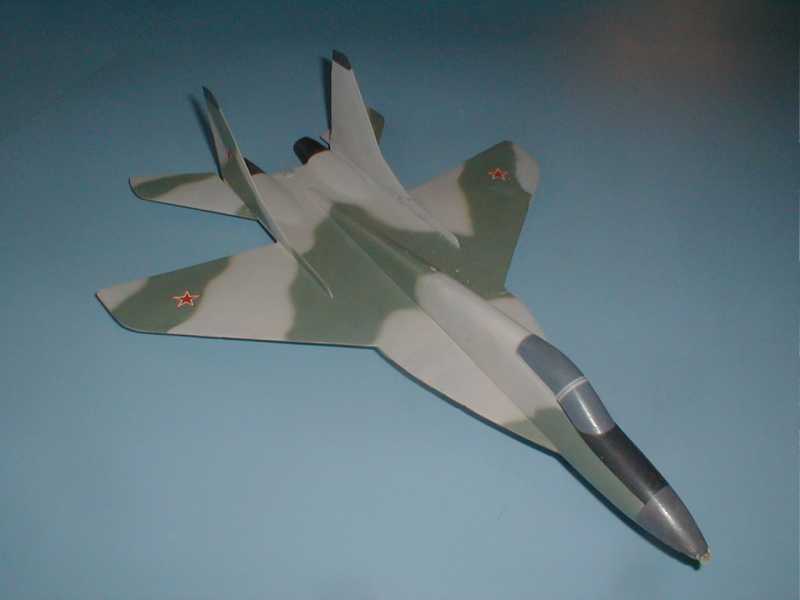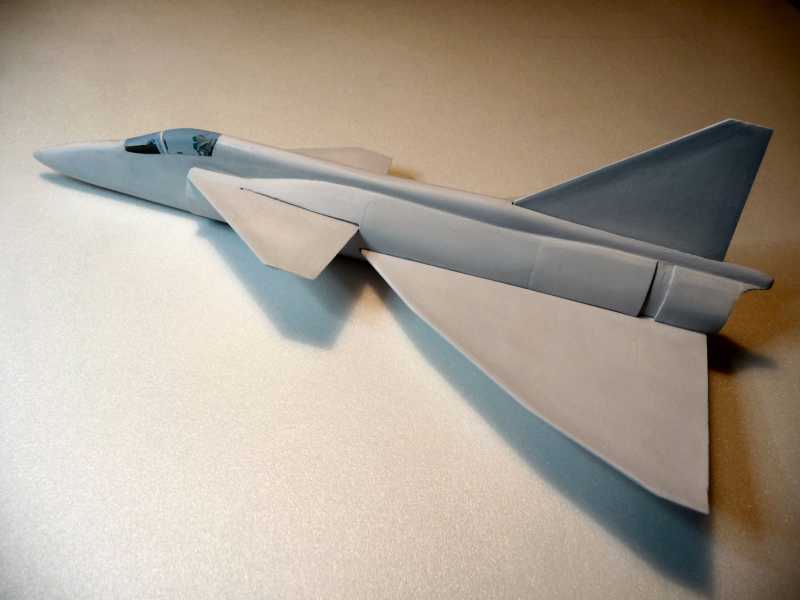Above: the flightline at Old Warden, introduced as a safety measure. Judging the best place to put it was not easy, and it was moved upwind early on Sunday because of the strengthening wind. It would be fair to say this new innovation [sic] was not univerally appreciated or adhered to. 
Saturday was scorching hot with practically no wind and the attendance was good. The flying was also good and plentiful - conditions were perfect apart from gusts later on occasioned by a thermal passing through.

Sunday however was cooler and windy, but thanks to the lack of trees and buildings upwind it was surprisingly free of the dreaded turbulence once you were above 20-30 ft off the ground. So, although many there didn't bother to fly because of the stiff (12 mph) breeze the models that were flown flew perfectly well and even stayed in the field, well for me anyway, which was a nice change.

During the seven hours I was on the field [mad dogs and Englishmen!] I initially flew some of my paper dart power unit powered Depron profile motors to get a feel for the conditions and then progressed to my Rapier powered profile Comet, Valiant, Skyray and BP 111A and semi profile Saab Viggen and MiG 29 and the built-up Swift.
Above: Howard's profile Comet made a number of flights, exhibiting a number of aerobatics which would have required passengers to fasten their seat belts (and probably reach for sick bags). A lovely flyer.
Above: the Valiant has a side mounted motor and thrust tab. It's quite sensitive to what thrust the L-2 gives.
Above: Howard's take on Bill Dean's classic Skyray. It made some lovely sorties.
Above: Howard's BP 111A prefers the ~ 90 mN of the old L-2 LT motors to the ~140 mN of the new ones. I'm sure it could be trimmed to take the extra oomph, but who wants to 'waste' motors doing this?
Both the Comet and Valiant gave me a fright on their first flights as they glided away in straight lines away from me after the power run. They were hard to see and appeared to disappear very low over ther hedge in the distance.

"Oh no, got to get through the hedge and search amongst the crops" I thought. But as I walked up to inspect the hedge ... just in case they had not gone over and were stuck in it I found them in the grass not far short of the Hedge. Hooray!

The Skyray did its usual variety of flights, depending on the variability of the power of each particular Rapier as each one does vary a bit. Generally it gave nice smooth climbing circuits on moderate power, or random loops and steeply banked turns on the more potent ones. But it is such a reliable flyer it could cope with varying thrusts and I would recommend it to anyone.
The highlight of the day for me was seeing the Mig 29 (from the
Aeromodeller design) circling in banked turns above my head and drifting slowly downwind then going off to one side in a straight line in a nice long glide, a lovely end to the day.
On Sunday I spent only six hours on the field[!] but in that time got to meet with Dr Z. I found him to be a very nice chap and bought some new Rapiers from him to top up my stock.
There were also lots of other fliers to meet on the field, one of the pleasures of such meetings, and I found them all a very nice bunch indeed -- to a man helpful and informative when asked about their models.
I flew less on Sunday as I was still tired from Saturday, but fly I did and I am very grateful to Andy and Roger and another chap who volunteered to collect my models at times from the other side of the field. A big thank you to you guys.
So what did I fly? ... basically the same Rapier models as Saturday plus a profile Starfighter, but I managed to damage the Swift, Valiant and BP111A when the extra power of the newer L-2 Rapiers caught me out. These profile models are easily repaired thankfully. I should have selected the next lower power grade i.e. a standard L-2 instead of an L-2X, as higher levels of power require the models to be re-trimmed -- it seems the rule that the faster they fly the harder they are to trim.

But, all in al, a good time was had by all. Long may these meetings continue!
Above: Howard's beautiful Swift flew well in Sunday's windy conditions ... until the inevitable CRUNCH! All balsa models tend to bounce better.
 P.S.
P.S. Personally I could have done without the flight line and also the so-called radio assist models sharing the same space as our genuine free flight models.
 PPS
PPS
There were two flights that shared flight of the day for me on Sunday, the first was my near twenty year old balsa profile Starfighter which needs a catapult launch (kindly assisted by Andy lighting the Rapier) as it is very tricky to hand launch. After several catapulted test launches to make sure it was flying straight I launched it slightly to the right of the breeze and after climbing out to about 30 feet it cruised fast in wide right hand wide circuits that covered most of the free flight area landing just inside the far hedge. Phew, I have not flown it for many years and it really surprised me how stable and smoothly it flew in that wind for such an unlikely anhedralled model layout. I got quite excited!
 Above: Howard's F-104 flew splendidly and stably despite the anhedral. It looked great in the air as well. Perhaps Howard will now make one which isn't 'au naturel'? There are many fantastic colour schemes out there!
Above: Howard's F-104 flew splendidly and stably despite the anhedral. It looked great in the air as well. Perhaps Howard will now make one which isn't 'au naturel'? There are many fantastic colour schemes out there!
The second contender was the last Mig 29 flight, I hand launched it banked slightly to the right, usually it then does circuits in the same turn but this time as is it climbed out to the right ahead of us it changed and curved round to the left. Continuing the turn it dived down back towards us and made a fast low pass over the flight line then up and to the left to cruise in smooth fast and wide left hand circuits leaving a faint smoke trail looking very much like the real thing. The model transitioned seamlessly to a satisfyingly long straight glide landing just inside the hedge, phew again.
 Above: Howard's all-sheet MiG 29 just loved the power of the latest L-2X motors and coped well with the conditions
Above: It was also great to see the Viggen fly with the latest batch of L-2X motors.
Above: Howard's all-sheet MiG 29 just loved the power of the latest L-2X motors and coped well with the conditions
Above: It was also great to see the Viggen fly with the latest batch of L-2X motors.


